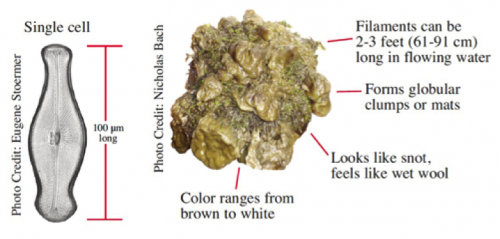National Invasive Species Awareness Week: Didymo
This invasive is often called 'rock snot' and looks like wet wool.

National Invasive Species Week 2017 is Feb. 27 to March 3. Invasive species are plants, animals, and other organisms that are not traditionally found in a given location (in this case the Great Lakes) AND are having a negative impact of some kind, whether ecological, economic, social, and/or a public health threat.
To help bring awareness to these threats, Michigan State University Extension and Michigan Sea Grant are featuring articles on invasive species that have invaded or have the potential to invade Michigan’s environment. This article features the aquatic invasive species didymo.
Species name: Didymo (Didymosphenia geminata)
Description: According to the Midwest Invasive Species Information Network this aquatic invasive species is a microscopic single-celled freshwater diatom (algae) whose cells can form stalks that attach to hard substrates such as rocks. It looks and feels like white or tan wet wool and is often referred to as “rock snot,” although it is not slimy.
Similar species: There are three species that are similar to didymo: Cymbella spp., Gomphoneis spp., and Gomphonema spp. However, didymo is differentiated by its color (brown, tan, yellow or white) and texture (not slimy).
Origin: Didymo is thought to be native to Lake Superior, parts of Canada and Northern Europe.
How it came to the Great Lakes: Didymo is believed to be native to the Great Lakes but its invasive character was only recorded in the late 1990s. It’s not known what conditions cause didymo to alter its native non-invasive character and form dense invasive mats, but some speculate that climate change could be playing a role.
Extent of range: Didymo was found east of the Mississippi in 2005 in Tennessee, west of the Mississippi in Montana, Utah, Colorado and South Dakota and was even documented in 2004 in New Zealand. In Michigan, it was discovered to be invasive in the St. Mary’s River near Sault Ste. Marie in 2015.
Why it is a problem: Didymo mats alter habitat and food sources for fish and can make recreation difficult or unpleasant. Mats can also clog water intakes and fishing gear as well as impact fishing access and wading.
How it is spread: According to the New York Department of Environmental Conservation didymo is spread by anglers, kayakers, canoeists, tubers, boaters and others engaging in water-based recreation can unknowingly spread didymo. The microscopic algae can cling - unseen - to waders, boots, boats, clothing, lures, hooks, fishing line and other equipment and remain viable for several weeks under even in seemingly dry conditions. However, others argue that didymo has always been present but invasive blooms have only recently been noticed.
A cool/unusual fact: Didymo is often confused for toilet paper or fiberglass.
Management actions/options: There are currently no known management actions or options. Eradicating infestations is impossible so prevention is key.
What you can do to help prevent the spread: You may be able to prevent the spread of water didymo by practicing the Clean, Drain and Dry method for watercraft prior to moving them between lakes. (See Video ) Equipment and gear can also be placed in a freezer until all moisture is frozen solid but freezing is a didymo specific treatment and will not necessarily prevent the spread of other invasive species of fish diseases and may damage some gear. Anglers should also consider alternatives to felt-soled waders (such as rubber studded boots) due to their ability to absorb didymo cells and to stay damp for prolonged periods of time. Felt-soled boots are a major vector in spreading didymo and require special treatment of prolonged soaking in disinfectant to effectively control didymo.
REPORT IT: If you find this algae in Michigan, remove it if possible, do not put it back in the water and call the Michigan Department of Natural Resources Wildlife Division at (517) 641-4903 ext. 260.
More invasive species resources:
Midwest Invasive Species Information Network didymo:
Fact Sheet
Mobile app
Michigan Natural Features Inventory:
Publications
Field Guide
Great Lakes Aquatic Nonindigenous Species Information System
Michigan Department of Natural Resources



 Print
Print Email
Email




